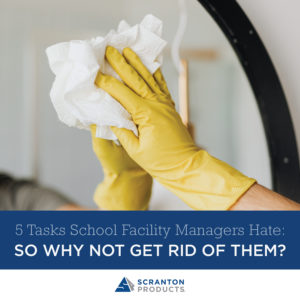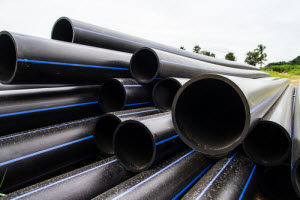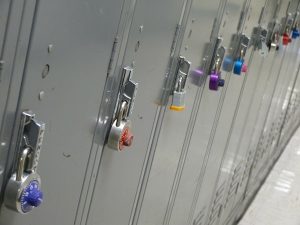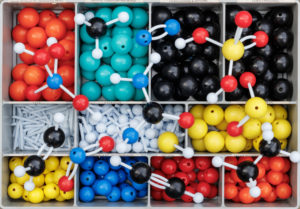The biggest concern for most people in a commercial restroom is privacy. In order to give employees and customers a better experience, commercial businesses should look toward a company that can provide:
- Higher Privacy Restroom Partitions
- Gender-Neutral Facilities
- Adequate Locks and Latches
- Maintenance and Cleanliness Features
- Accessibility Designs
Higher Privacy Restroom Partitions
There are a few ways that you can make the experience of going to the bathroom a little more comfortable for the occupants. However, the best way is by installing restroom partitions that offer more security and privacy, as well as customizable options to reduce exposed areas or sightlines. Scranton Products® has partitions available in different height options, privacy features and price ranges that easily fit in commercial restroom spaces.
Aria Partitions® provide increased privacy, many design choices and innovative features that will significantly upgrade the look of your room and add a whole new level of privacy. The system has full height options with an edge mounted hinge and shiplap edges to reduce sightlines. The system is floor supported, meaning it does not need to tie into the ceiling for floor to ceiling configurations. This creates tremendous design flexibility and ease of installation.
Eclipse Partitions® offer a sleek and contemporary design with multiple height options that uses hidden hardware and handles with occupancy indicators that increase the privacy of the commercial bathroom experience. Additionally, this system comes with an edge mounted hinge and shiplap edges to reduce sightlines.
Hiny Hiders® Signature Series provides different height options for increased privacy. Sightlines can be removed without the use of hardware or by specifying a shiplap cut edge.
Gender-Neutral Facilities
With gender-neutral bathrooms on the rise, it is time for architects to take a fresh look at how their designs are helping users feel safe.
The adoption of gender-neutral restrooms has gained momentum in recent years due to a growing awareness of gender inclusivity and the recognition of diverse gender identities. High-privacy restroom partitions reduce sightlines and boast enclosed compartments that are not only attractive but also gender-neutral friendly.
Many companies and organizations have adopted policies and initiatives that support diversity, equity, and inclusion. Providing gender-neutral facilities aligns with these values and initiatives.
Adequate Locks and Latches
When designing a restroom, all aspects need to be reviewed, including the locks and latches. Scranton Products has many options available for emergency access. You never know when an emergency will happen and having emergency access options allows responders to reach someone inside the stall that may need assistance or medical attention quickly without any hindrance. Having emergency access can also make it easier for janitorial staff to enter and clean the restroom without disrupting the normal operation of the stall doors.
Maintenance and Cleanliness
Each Scranton Products partition system has features that allow for easy maintenance.
Because Scranton Products systems are made of HDPE, it is impermeable to moisture, low-maintenance and helps to minimize bacteria growth.* HDPE materials are also resistant to impact and graffiti. They can be power washed when a deep cleaning is needed.
Aria Partions have innovative solutions including a shoeless pilaster design which creates a cleaner aesthetic while eliminating a spot notorious for dirt collection. Eclipse Partitions are designed with a post that allows for ease of cleaning the floors and Hiny Hiders have different options, including ceiling hung, to allow for a quicker cleaning of the floors.
Accessibility
Accessibility in a restroom is important for ensuring that individuals with disabilities can use the facilities comfortably and independently. Accessible restrooms ensure that everyone, regardless of physical abilities, can access and use restroom facilities. It promotes inclusivity and helps create an environment that is welcoming to people with disabilities. Proper space, layout, and features contribute to a more comfortable and private restroom experience. Please review all local and international codes to know which codes apply.
About Scranton Products
With more than 30 years of experience, Scranton Products is the industry leader in plastic bathroom partitions and lockers. Endless design options and an array of designer colors and textures provide confidence and elegant style in every project, creating a lasting impression. Proudly made in the USA and constructed from premium-grade solid plastic, our products’ unmatched durability withstands impact, corrosion, graffiti, and mildew. Backed by sustainable technologies and industry-leading warranties, with our partitions and lockers you are investing in peace of mind.
*Read about our brands’ health and safety: https://www.scrantonproducts.com/better-safety/


 especially true when it comes to choosing your toilet partitions and stalls. You don’t want to make any mistakes and choose the wrong material that will require a lot of upkeep—or, even worse, an early replacement.
especially true when it comes to choosing your toilet partitions and stalls. You don’t want to make any mistakes and choose the wrong material that will require a lot of upkeep—or, even worse, an early replacement. scratches, dents, impacts, and even graffiti. HDPE partitions also offer a reduction in noise, providing a softer sound when being shut.
scratches, dents, impacts, and even graffiti. HDPE partitions also offer a reduction in noise, providing a softer sound when being shut. Now that you’ve got your time to paint, you need your place. Find an open area in the school that you can paint. It will allow you to have the room to paint multiple lockers, so you can start getting the job done. That way, you can reinstall the lockers quickly. You can paint the lockers where they stand, but you’ll need plenty of tarp or drop cloth coverage to prevent any paint from getting on the floor or the wall.
Now that you’ve got your time to paint, you need your place. Find an open area in the school that you can paint. It will allow you to have the room to paint multiple lockers, so you can start getting the job done. That way, you can reinstall the lockers quickly. You can paint the lockers where they stand, but you’ll need plenty of tarp or drop cloth coverage to prevent any paint from getting on the floor or the wall. Metal lockers are very durable and reliable storage compartments for the students. Sometimes, though, their maintenance, care, and upkeep outweigh their usefulness compared to plastic lockers. The constant maintenance and repainting certainly adds to the locker’s costs. What you need is a reliable locker that doesn’t require the constant upkeep while retaining its appearance and durability.
Metal lockers are very durable and reliable storage compartments for the students. Sometimes, though, their maintenance, care, and upkeep outweigh their usefulness compared to plastic lockers. The constant maintenance and repainting certainly adds to the locker’s costs. What you need is a reliable locker that doesn’t require the constant upkeep while retaining its appearance and durability. You may not really take the time to consider the variety of materials that can be used as toilet partitions. However, reviewing all of your options can allow you to make the best choice for your facility. Most toilet partitions are made from plastic with an inner core made from kraft paper or cardboard. Materials like Phenolic, Baked Enamel, and Plastic Laminate may look nice in your restroom, but they may be left vulnerable to the moisture and humidity in your restroom. The inner core will absorb the moisture, and over time, it’ll sprout mold, leading to a pungent odor and a substantial problem to solve.
You may not really take the time to consider the variety of materials that can be used as toilet partitions. However, reviewing all of your options can allow you to make the best choice for your facility. Most toilet partitions are made from plastic with an inner core made from kraft paper or cardboard. Materials like Phenolic, Baked Enamel, and Plastic Laminate may look nice in your restroom, but they may be left vulnerable to the moisture and humidity in your restroom. The inner core will absorb the moisture, and over time, it’ll sprout mold, leading to a pungent odor and a substantial problem to solve.


